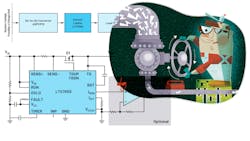Adding a Flexible Current Limit (.PDF Download)
In some power-management applications, precise current limiting is required. This is necessary either to protect the energy source—for example, if an intermediate circuit voltage requires overload protection so that it can reliably supply other system parts with energy—or to protect a load that can cause damage due to overcurrent in a fault condition.
In the search for a suitable dc-dc point-of-load (PoL) regulator to meet this requirement, you’ll find very few voltage converters with adjustable current limit on the market. While adjustable current limit is more often found on controller designs with external power switches, all integrated solutions seldomly offer such functionality. Also, adjustable current limits typically don’t have very high accuracy. On top of that, the current limiters in dc-dc converter ICs usually only limit the inductor current and not the input or output current of the power supply.
